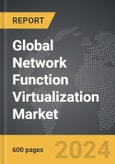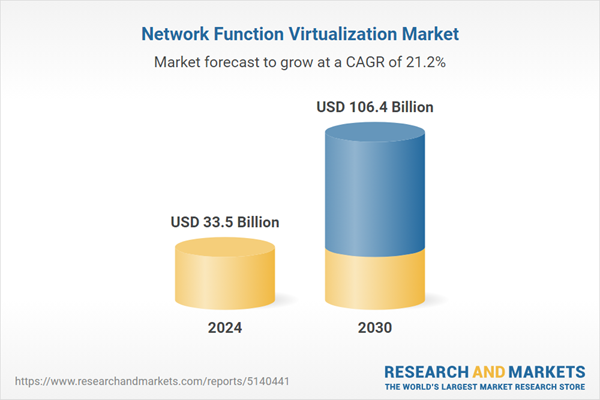The global market for Network Function Virtualization was valued at US$33.5 Billion in 2024 and is projected to reach US$106.4 Billion by 2030, growing at a CAGR of 21.2% from 2024 to 2030. This comprehensive report provides an in-depth analysis of market trends, drivers, and forecasts, helping you make informed business decisions. The report includes the most recent global tariff developments and how they impact the Network Function Virtualization market.
The implementation of NFV involves several critical components, including the NFV Infrastructure (NFVI), which provides the physical and virtual resources needed to support VNFs, and the NFV Management and Orchestration (MANO) framework, which oversees the lifecycle management of VNFs. NFV's adoption is being driven by the rise of 5G networks, which require a more agile and scalable network architecture to support the increased demand for bandwidth and low-latency applications. Additionally, NFV is instrumental in enabling edge computing, where computing resources are distributed closer to end-users to enhance performance and reliability. The move towards software-defined networking (SDN) complements NFV by providing a programmable network fabric that can dynamically adjust to changing traffic patterns and service requirements.
The growth in the Network Function Virtualization market is driven by several factors that reflect the evolving technological landscape and industry needs. The rapid deployment and expansion of 5G networks globally have been a significant driver, as NFV provides the necessary scalability and flexibility to support new 5G use cases, such as IoT and enhanced mobile broadband. Enterprises are increasingly adopting NFV to streamline their network operations and reduce capital and operational expenditures by shifting to software-based network functions. The rise of cloud computing and the trend towards hybrid and multi-cloud environments have also spurred NFV adoption, as businesses seek more agile and cost-effective network solutions. Furthermore, the growing importance of edge computing to reduce latency and improve service quality for applications like autonomous vehicles, smart cities, and immersive media drives the demand for NFV. These trends are supported by continuous advancements in virtualization technologies, robust security frameworks, and the development of comprehensive NFV standards, which collectively ensure the sustained growth and evolution of the NFV market.
Segments: Component (Orchestration & Automation, Solutions, Services); End-User (Service Providers, Data Centers, Enterprises).
Geographic Regions/Countries: World; USA; Canada; Japan; China; Europe; France; Germany; Italy; UK; Spain; Russia; Rest of Europe; Asia-Pacific; Australia; India; South Korea; Rest of Asia-Pacific; Latin America; Argentina; Brazil; Mexico; Rest of Latin America; Middle East; Iran; Israel; Saudi Arabia; UAE; Rest of Middle East; Africa.
The analysts continuously track trade developments worldwide, drawing insights from leading global economists and over 200 industry and policy institutions, including think tanks, trade organizations, and national economic advisory bodies. This intelligence is integrated into forecasting models to provide timely, data-driven analysis of emerging risks and opportunities.
Global Network Function Virtualization Market - Key Trends & Drivers Summarized
Network Function Virtualization (NFV) represents a transformative approach in the realm of network architecture, fundamentally altering how network services are designed, deployed, and managed. Traditionally, network functions were tightly coupled with dedicated hardware appliances, such as routers, firewalls, and load balancers. NFV decouples these functions from the underlying hardware, enabling them to run on general-purpose servers and storage. This shift is facilitated by virtualization technologies that allow for the creation of virtualized network functions (VNFs) that can be dynamically deployed, scaled, and managed. NFV offers significant advantages in terms of cost reduction, flexibility, and speed of service delivery, making it a cornerstone technology for modern telecommunications and enterprise networks.The implementation of NFV involves several critical components, including the NFV Infrastructure (NFVI), which provides the physical and virtual resources needed to support VNFs, and the NFV Management and Orchestration (MANO) framework, which oversees the lifecycle management of VNFs. NFV's adoption is being driven by the rise of 5G networks, which require a more agile and scalable network architecture to support the increased demand for bandwidth and low-latency applications. Additionally, NFV is instrumental in enabling edge computing, where computing resources are distributed closer to end-users to enhance performance and reliability. The move towards software-defined networking (SDN) complements NFV by providing a programmable network fabric that can dynamically adjust to changing traffic patterns and service requirements.
The growth in the Network Function Virtualization market is driven by several factors that reflect the evolving technological landscape and industry needs. The rapid deployment and expansion of 5G networks globally have been a significant driver, as NFV provides the necessary scalability and flexibility to support new 5G use cases, such as IoT and enhanced mobile broadband. Enterprises are increasingly adopting NFV to streamline their network operations and reduce capital and operational expenditures by shifting to software-based network functions. The rise of cloud computing and the trend towards hybrid and multi-cloud environments have also spurred NFV adoption, as businesses seek more agile and cost-effective network solutions. Furthermore, the growing importance of edge computing to reduce latency and improve service quality for applications like autonomous vehicles, smart cities, and immersive media drives the demand for NFV. These trends are supported by continuous advancements in virtualization technologies, robust security frameworks, and the development of comprehensive NFV standards, which collectively ensure the sustained growth and evolution of the NFV market.
Report Scope
The report analyzes the Network Function Virtualization market, presented in terms of units. The analysis covers the key segments and geographic regions outlined below.Segments: Component (Orchestration & Automation, Solutions, Services); End-User (Service Providers, Data Centers, Enterprises).
Geographic Regions/Countries: World; USA; Canada; Japan; China; Europe; France; Germany; Italy; UK; Spain; Russia; Rest of Europe; Asia-Pacific; Australia; India; South Korea; Rest of Asia-Pacific; Latin America; Argentina; Brazil; Mexico; Rest of Latin America; Middle East; Iran; Israel; Saudi Arabia; UAE; Rest of Middle East; Africa.
Key Insights:
- Market Growth: Understand the significant growth trajectory of the Orchestration & Automation segment, which is expected to reach US$48.1 Billion by 2030 with a CAGR of a 20.5%. The Solutions segment is also set to grow at 21.3% CAGR over the analysis period.
- Regional Analysis: Gain insights into the U.S. market, valued at $9.3 Billion in 2024, and China, forecasted to grow at an impressive 24.3% CAGR to reach $10.9 Billion by 2030. Discover growth trends in other key regions, including Japan, Canada, Germany, and the Asia-Pacific.
Why You Should Buy This Report:
- Detailed Market Analysis: Access a thorough analysis of the Global Network Function Virtualization Market, covering all major geographic regions and market segments.
- Competitive Insights: Get an overview of the competitive landscape, including the market presence of major players across different geographies.
- Future Trends and Drivers: Understand the key trends and drivers shaping the future of the Global Network Function Virtualization Market.
- Actionable Insights: Benefit from actionable insights that can help you identify new revenue opportunities and make strategic business decisions.
Key Questions Answered:
- How is the Global Network Function Virtualization Market expected to evolve by 2030?
- What are the main drivers and restraints affecting the market?
- Which market segments will grow the most over the forecast period?
- How will market shares for different regions and segments change by 2030?
- Who are the leading players in the market, and what are their prospects?
Report Features:
- Comprehensive Market Data: Independent analysis of annual sales and market forecasts in US$ Million from 2024 to 2030.
- In-Depth Regional Analysis: Detailed insights into key markets, including the U.S., China, Japan, Canada, Europe, Asia-Pacific, Latin America, Middle East, and Africa.
- Company Profiles: Coverage of players such as Cisco Systems, Inc., Broadcom Inc., Ciena Corporation, AMDOCS, AudioCodes Ltd. and more.
- Complimentary Updates: Receive free report updates for one year to keep you informed of the latest market developments.
Some of the 78 companies featured in this Network Function Virtualization market report include:
- Cisco Systems, Inc.
- Broadcom Inc.
- Ciena Corporation
- AMDOCS
- AudioCodes Ltd.
- Array Networks, Inc.
- A10 Networks, Inc.
- Arista Networks, Inc.
- Adva Optical Networking SE
- 6WIND
- Affirmed Networks
- Calsoft Inc.
- Cirrus Core Networks
- Aptira
- CED Systems
Tariff Impact Analysis: Key Insights for 2025
Global tariff negotiations across 180+ countries are reshaping supply chains, costs, and competitiveness. This report reflects the latest developments as of April 2025 and incorporates forward-looking insights into the market outlook.The analysts continuously track trade developments worldwide, drawing insights from leading global economists and over 200 industry and policy institutions, including think tanks, trade organizations, and national economic advisory bodies. This intelligence is integrated into forecasting models to provide timely, data-driven analysis of emerging risks and opportunities.
What’s Included in This Edition:
- Tariff-adjusted market forecasts by region and segment
- Analysis of cost and supply chain implications by sourcing and trade exposure
- Strategic insights into geographic shifts
Buyers receive a free July 2025 update with:
- Finalized tariff impacts and new trade agreement effects
- Updated projections reflecting global sourcing and cost shifts
- Expanded country-specific coverage across the industry
Table of Contents
I. METHODOLOGYII. EXECUTIVE SUMMARY2. FOCUS ON SELECT PLAYERSIII. MARKET ANALYSISSOUTH KOREAREST OF ASIA-PACIFICARGENTINABRAZILMEXICOREST OF LATIN AMERICAIRANISRAELSAUDI ARABIAUNITED ARAB EMIRATESREST OF MIDDLE EASTIV. COMPETITION
1. MARKET OVERVIEW
3. MARKET TRENDS & DRIVERS
4. GLOBAL MARKET PERSPECTIVE
UNITED STATES
CANADA
JAPAN
CHINA
EUROPE
FRANCE
GERMANY
ITALY
UNITED KINGDOM
SPAIN
RUSSIA
REST OF EUROPE
ASIA-PACIFIC
AUSTRALIA
INDIA
LATIN AMERICA
MIDDLE EAST
AFRICA
Companies Mentioned (Partial List)
A selection of companies mentioned in this report includes, but is not limited to:
- Cisco Systems, Inc.
- Broadcom Inc.
- Ciena Corporation
- AMDOCS
- AudioCodes Ltd.
- Array Networks, Inc.
- A10 Networks, Inc.
- Arista Networks, Inc.
- Adva Optical Networking SE
- 6WIND
- Affirmed Networks
- Calsoft Inc.
- Cirrus Core Networks
- Aptira
- CED Systems
Table Information
| Report Attribute | Details |
|---|---|
| No. of Pages | 600 |
| Published | April 2025 |
| Forecast Period | 2024 - 2030 |
| Estimated Market Value ( USD | $ 33.5 Billion |
| Forecasted Market Value ( USD | $ 106.4 Billion |
| Compound Annual Growth Rate | 21.2% |
| Regions Covered | Global |









